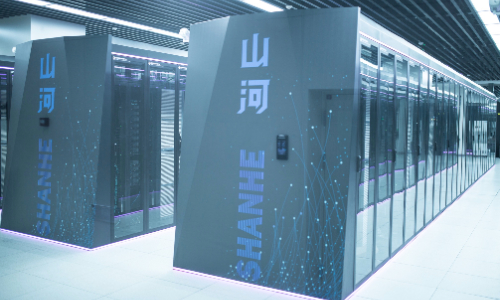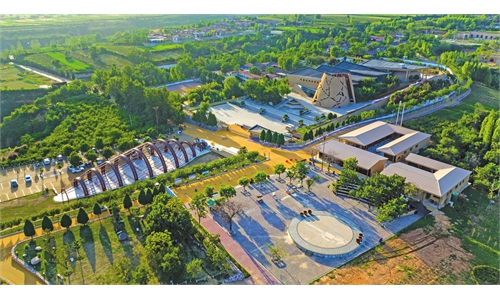Editor's Note:
The Yellow River is regarded as the "Mother River" of the Chinese nation. For thousands of years, its basin has been a political, economic, and cultural hub in the long history of the Chinese civilization. Today, the 5,464-kilometer-long waterway has fed 12 percent of China's population, irrigated 17 percent of all arable land, and supplied water to more than 50 large- and medium-sized cities.
Because of its incomparable historical, cultural, and economic significance, together with its impact on the environment, great efforts must be brought to bear in the protection of the river and its basin. The Global Times will publish a series of stories to showcase the progress of development along the Mother River, and the people's love and happiness tied to the ancient waterway.
In this fourth installment, we stepped into the National Supercomputing Center in Jinan, East China's Shandong Province. This center represents China's top level of supercomputing, and will serve as a "brain" of the high-quality development in the Yellow River Basin.

Today, supercomputing has become an important index of measure for the technological level and innovation capability of a country or region, and it is also an important indicator for promoting high-quality economic and social development, promoting industrial transformation, and improving people's livelihoods.
It is an important means of well-being and safeguards national security, and is known as one of the"pillars of a great power era of intelligence."
Located in the capital city of Shandong Province, the National Supercomputing Center in Jinan (NSCCJN) is the birthplace of China's petaflop-level supercomputer Sunway BlueLight, which was completely developed using independent processors. The center is leading China's supercomputing industry.
In recent years, despite the complex situation of Western technology blockade and the COVID-19 pandemic, the NSCCJN has continuously made breakthroughs, played a strong supportive role in many fields such as in the economy, scientific research, education, and people's daily lives, and is committed to high-quality development in the entire Yellow River Basin, serving as "the most powerful brain."
So what exactly does a supercomputer look like? What kind of jobs are supercomputers already capable of? How can China's supercomputing development seek independent innovation and break through the blockade? With these questions in mind, the Global Times reporter visited the NSCCJN.

Multiple tasks
The Jinan Supercomputing Center Science and Technology Park, opened in 2019, is the world's first such park. And the giant circular headquarter building of National Supercomputing Center in Jinan sits at the center of the park.
Inside the center, thousands of cabinets, each as high as an adult man, sit neatly and quietly behind glass. The black cabinets are engraved with the Chinese characters "Shanhe" meaning "mountains and rivers."
The Shanhe supercomputing platformis a Chinese-developed storage system for a supercomputer. This year, it beat other systems in the world on the IO-500 10 Node Challenge, which aims to compare storage systems of some of the world's fastest supercomputers. Moreover, it greatly refreshed the best record in the history of the IO-500 list, which was released at the International Supercomputing Conference (ISC) High Performance 2022 in Hamburg, Germany.
"Shanhe system is another one of the achievements in the glorious journey of the NSCCJN," Pan Jingshan, vice director at the center and head of the Jinan Institute of Supercomputing Technology, told the Global Times.
Panintroduced that in 2011, with the approval of the Ministry of Science and Technology, NSCCJN was established. In that year, it built Sunway Bluelight, China's first petaflop supercomputer with its own CPU.
In 2018, the Sunway E-class prototype computer was built, realizing the complete localization of core components for the first time.
This year, NSCCJN's Sunway Bluelight II, the second-generation of Sunway Bluelight, increased computing power 14 times over, and realize complete autonomy and controllability of core technologies in the field of supercomputing, and has expanded supercomputing from scientific research to industrial application. "The development of the world's supercomputing industry has entered the 2.0 era," Pan said.
In a room with a giant main control screen, in front of a flock of visiting students, a staff member introduces the supercomputing cloud platform for the country's environment monitoring use of big data.
The platform, launched in March 2021, can predict and forecast air quality across the country. It contains more than 14,000 computing cores and operates around the clock.
According to Pan, at present, NSCCJN is still cooperating with the Ministry of Ecology and Environment to predict the national carbon emissions, which will not only help China achieve its "dual carbon" goal, but also safeguard China's rights and interests in the future international carbon trading game.
This is one of the examples of multi-field applications of NSCCJN. In recent years, the center has made a series of major breakthroughs in the fields of computing and network integration, ecological environmental protection, ocean, medical care, education, and governance. It has also served more than 2,000 users, including universities, government departments, and companies, bringing great opportunities for technological innovation in various fields.
Leading the world
In the latest TOP500 list, which is released by the International Supercomputing Organization to rank the 500 most powerful non-distributed computer systems in the world, China had a total of 162 supercomputers on the list, ranking first for the 10th consecutive time.
But when it comes to best performance, China's supercomputers did not come out on top. The "Frontier," at the Oak Ridge National Laboratory affiliated to the US Department of Energy ranked first, followed by "Fugaku" jointly developed by Fujitsu and the Riken Center for Computational Science in Japan.
Among the top ten, the "Sunway TaihuLight" of the National Supercomputing Center in Wuxi, East China's Jiangsu Province and "Tianhe-2A" of the National Supercomputing Center in Guangzhou ranked seventh and tenth respectively. The two supercomputers were put into use in 2016 and 2018 respectively.
As a result, some people question why China does not have supercomputers with better performance at the top of the list in recent years. They question what the real capability of China's supercomputing is.
"Definitely the top echelon," Pan said with certainty. "The competition in the field of international supercomputing now is performance and application. A decade ago, perhaps we were still following, but now we are definitely in the leading stage."
He explained that Jinan has built the second-generation of Sunway Bluelight, but now China's supercomputing no longer pays much attention to international ranking, rather focuses more on the application of supercomputing in reality to create a technological environment in China which is also one of the features and key tasks of the NSCCJN.
According to Pan, the center has now transplanted 1,300 bits of common computing software, and has been working with universities, institutes, and high-tech companies to promote the rapid development of China's supercomputing technologies and applications.

At the same time, under the complex international situation, China's supercomputers are also facing new difficulties and challenges.
"But this does not mean that the development of supercomputers in China has stalled." Pan said, "In fact, China's supercomputers are seeking to break through the barrier in all aspects."
According to Pan, to break through the blockade, efforts in multiple aspects would need to be employed. For example, in terms of basic chips, it requires the coordinated breakthrough of the entire country. Secondly, in terms of basic software, China's huge number of engineering graduates will be a bonus, which will help solve somedifficultproblems in the field.
"China's supercomputing must first be positioned as a public support platform and a nationally large scientific device. It must be led by the country and should have a good top-level design," Pan concluded.
Zhao Lijian, China's foreign ministry spokesperson, said on April 9, 2021 that "Despite the long-existing US technology blockade of China in supercomputing, China has become a frontrunner in this field with its independent innovation."
A decade of exponential development
China's supercomputing has gone from being in the hands of others to leading the world, which is the result of the joint efforts of several generations of scientific researchers.
The development of supercomputers in China can be traced back to 1976 before the reform and opening up. At that time, formerleader Deng Xiaoping proposed to establish a "computing center" in each province.
In thelate1970s, Chinese researchers who wanted to use supercomputers could only do so in a glass room under the 24-hour supervision of American technicians. The computer startup password and computer room keys were also under US supervision. Without permission, Chinese researchers couldn't even enter the "glass house."
Chinese researchers worked hard and started to develop their own supercomputers. In 1983, China successfully developed its first supercomputer with 100 million operations per second, known as the "Yinhe-1." From then on, China's supercomputing industry has gradually transitioned into the fast lane.
In the last decade, China's supercomputers have ushered in an era of exponential growth.
With a huge user base, complete industrial chain, and a positive, open attitude, China's supercomputing has witnessed exponential development.
In Jinan, the supercomputers have also been upgrading - they have taken up increasingly smaller areas with lower energy consumption and costs, while their overall performance and computing power keeps increasing.
China's supercomputers have achieved full independence with core components to system software and full intellectual property rights, realizing complete autonomy and adaptability of core technologies in the field of supercomputing.
However, in actual work, Pan feels that the field of supercomputing still needs to strengthen the cultivation of interdisciplinary talents. "The iterative speed of computers is too fast, and we need more young talents to serve as decision makers, adapt to new ideas, and learn new knowledge."
'The most powerful brain'
In recent years, ecological protection and high-quality development of the Yellow River Basin has been a major national strategy.
The supercomputers in Jinan will play the "brain" role in this process.
In order to meet the urgent demand for mass computing power for high-quality development, the NSCCJN proposed an overall plan to build a computing power circle in the Yellow River Basin, which contains four national computing centers along the river, together with three national computing hubs.
This action will support the construction of the national supercomputing internet and integrated big data center, and serve the national strategy in full swing to channel more computing resources from the eastern areas to the less developed western regions.
"This layout not only makes use of the cheaper hydropower resources in the west, but will also effectively promote the development and progress of the inland provinces in the west," Pan said.
At present, the NSCCJN has been providing data support to disaster reduction, ecological and environmental governance, land and space planning, agricultural seeding, the Yellow River Delta wetland management, water conservancy restoration, residents' relocation, and other fields.
In the future, the center will further empower ecological protection and the high-quality development of the Yellow River Basin.
Wang Cong contributed to the story
The Yellow River is regarded as the "Mother River" of the Chinese nation. For thousands of years, its basin has been a political, economic, and cultural hub in the long history of the Chinese civilization. Today, the 5,464-kilometer-long waterway has fed 12 percent of China's population, irrigated 17 percent of all arable land, and supplied water to more than 50 large- and medium-sized cities.
Because of its incomparable historical, cultural, and economic significance, together with its impact on the environment, great efforts must be brought to bear in the protection of the river and its basin. The Global Times will publish a series of stories to showcase the progress of development along the Mother River, and the people's love and happiness tied to the ancient waterway.
In this fourth installment, we stepped into the National Supercomputing Center in Jinan, East China's Shandong Province. This center represents China's top level of supercomputing, and will serve as a "brain" of the high-quality development in the Yellow River Basin.

National Supercomputing Center in Jinan, East China's Shandong Province Photo: Courtesy of NSCCJN
Today, supercomputing has become an important index of measure for the technological level and innovation capability of a country or region, and it is also an important indicator for promoting high-quality economic and social development, promoting industrial transformation, and improving people's livelihoods.
It is an important means of well-being and safeguards national security, and is known as one of the"pillars of a great power era of intelligence."
Located in the capital city of Shandong Province, the National Supercomputing Center in Jinan (NSCCJN) is the birthplace of China's petaflop-level supercomputer Sunway BlueLight, which was completely developed using independent processors. The center is leading China's supercomputing industry.
In recent years, despite the complex situation of Western technology blockade and the COVID-19 pandemic, the NSCCJN has continuously made breakthroughs, played a strong supportive role in many fields such as in the economy, scientific research, education, and people's daily lives, and is committed to high-quality development in the entire Yellow River Basin, serving as "the most powerful brain."
So what exactly does a supercomputer look like? What kind of jobs are supercomputers already capable of? How can China's supercomputing development seek independent innovation and break through the blockade? With these questions in mind, the Global Times reporter visited the NSCCJN.

The sand table of National Supercomputing Center in Jinan, East China's Shandong Province Photo: Shan Jie/GT
Multiple tasks
The Jinan Supercomputing Center Science and Technology Park, opened in 2019, is the world's first such park. And the giant circular headquarter building of National Supercomputing Center in Jinan sits at the center of the park.
Inside the center, thousands of cabinets, each as high as an adult man, sit neatly and quietly behind glass. The black cabinets are engraved with the Chinese characters "Shanhe" meaning "mountains and rivers."
The Shanhe supercomputing platformis a Chinese-developed storage system for a supercomputer. This year, it beat other systems in the world on the IO-500 10 Node Challenge, which aims to compare storage systems of some of the world's fastest supercomputers. Moreover, it greatly refreshed the best record in the history of the IO-500 list, which was released at the International Supercomputing Conference (ISC) High Performance 2022 in Hamburg, Germany.
"Shanhe system is another one of the achievements in the glorious journey of the NSCCJN," Pan Jingshan, vice director at the center and head of the Jinan Institute of Supercomputing Technology, told the Global Times.
Panintroduced that in 2011, with the approval of the Ministry of Science and Technology, NSCCJN was established. In that year, it built Sunway Bluelight, China's first petaflop supercomputer with its own CPU.
In 2018, the Sunway E-class prototype computer was built, realizing the complete localization of core components for the first time.
This year, NSCCJN's Sunway Bluelight II, the second-generation of Sunway Bluelight, increased computing power 14 times over, and realize complete autonomy and controllability of core technologies in the field of supercomputing, and has expanded supercomputing from scientific research to industrial application. "The development of the world's supercomputing industry has entered the 2.0 era," Pan said.
In a room with a giant main control screen, in front of a flock of visiting students, a staff member introduces the supercomputing cloud platform for the country's environment monitoring use of big data.
The platform, launched in March 2021, can predict and forecast air quality across the country. It contains more than 14,000 computing cores and operates around the clock.
According to Pan, at present, NSCCJN is still cooperating with the Ministry of Ecology and Environment to predict the national carbon emissions, which will not only help China achieve its "dual carbon" goal, but also safeguard China's rights and interests in the future international carbon trading game.
This is one of the examples of multi-field applications of NSCCJN. In recent years, the center has made a series of major breakthroughs in the fields of computing and network integration, ecological environmental protection, ocean, medical care, education, and governance. It has also served more than 2,000 users, including universities, government departments, and companies, bringing great opportunities for technological innovation in various fields.
Leading the world
In the latest TOP500 list, which is released by the International Supercomputing Organization to rank the 500 most powerful non-distributed computer systems in the world, China had a total of 162 supercomputers on the list, ranking first for the 10th consecutive time.
But when it comes to best performance, China's supercomputers did not come out on top. The "Frontier," at the Oak Ridge National Laboratory affiliated to the US Department of Energy ranked first, followed by "Fugaku" jointly developed by Fujitsu and the Riken Center for Computational Science in Japan.
Among the top ten, the "Sunway TaihuLight" of the National Supercomputing Center in Wuxi, East China's Jiangsu Province and "Tianhe-2A" of the National Supercomputing Center in Guangzhou ranked seventh and tenth respectively. The two supercomputers were put into use in 2016 and 2018 respectively.
As a result, some people question why China does not have supercomputers with better performance at the top of the list in recent years. They question what the real capability of China's supercomputing is.
"Definitely the top echelon," Pan said with certainty. "The competition in the field of international supercomputing now is performance and application. A decade ago, perhaps we were still following, but now we are definitely in the leading stage."
He explained that Jinan has built the second-generation of Sunway Bluelight, but now China's supercomputing no longer pays much attention to international ranking, rather focuses more on the application of supercomputing in reality to create a technological environment in China which is also one of the features and key tasks of the NSCCJN.
According to Pan, the center has now transplanted 1,300 bits of common computing software, and has been working with universities, institutes, and high-tech companies to promote the rapid development of China's supercomputing technologies and applications.

Cabinets of the Shanhe supercomputing platform in the National Supercomputing Center in Jinan Photo: Shan Jie/GT
At the same time, under the complex international situation, China's supercomputers are also facing new difficulties and challenges.
"But this does not mean that the development of supercomputers in China has stalled." Pan said, "In fact, China's supercomputers are seeking to break through the barrier in all aspects."
According to Pan, to break through the blockade, efforts in multiple aspects would need to be employed. For example, in terms of basic chips, it requires the coordinated breakthrough of the entire country. Secondly, in terms of basic software, China's huge number of engineering graduates will be a bonus, which will help solve somedifficultproblems in the field.
"China's supercomputing must first be positioned as a public support platform and a nationally large scientific device. It must be led by the country and should have a good top-level design," Pan concluded.
Zhao Lijian, China's foreign ministry spokesperson, said on April 9, 2021 that "Despite the long-existing US technology blockade of China in supercomputing, China has become a frontrunner in this field with its independent innovation."
A decade of exponential development
China's supercomputing has gone from being in the hands of others to leading the world, which is the result of the joint efforts of several generations of scientific researchers.
The development of supercomputers in China can be traced back to 1976 before the reform and opening up. At that time, formerleader Deng Xiaoping proposed to establish a "computing center" in each province.
In thelate1970s, Chinese researchers who wanted to use supercomputers could only do so in a glass room under the 24-hour supervision of American technicians. The computer startup password and computer room keys were also under US supervision. Without permission, Chinese researchers couldn't even enter the "glass house."
Chinese researchers worked hard and started to develop their own supercomputers. In 1983, China successfully developed its first supercomputer with 100 million operations per second, known as the "Yinhe-1." From then on, China's supercomputing industry has gradually transitioned into the fast lane.
In the last decade, China's supercomputers have ushered in an era of exponential growth.
With a huge user base, complete industrial chain, and a positive, open attitude, China's supercomputing has witnessed exponential development.
In Jinan, the supercomputers have also been upgrading - they have taken up increasingly smaller areas with lower energy consumption and costs, while their overall performance and computing power keeps increasing.
China's supercomputers have achieved full independence with core components to system software and full intellectual property rights, realizing complete autonomy and adaptability of core technologies in the field of supercomputing.
However, in actual work, Pan feels that the field of supercomputing still needs to strengthen the cultivation of interdisciplinary talents. "The iterative speed of computers is too fast, and we need more young talents to serve as decision makers, adapt to new ideas, and learn new knowledge."
'The most powerful brain'
In recent years, ecological protection and high-quality development of the Yellow River Basin has been a major national strategy.
The supercomputers in Jinan will play the "brain" role in this process.
In order to meet the urgent demand for mass computing power for high-quality development, the NSCCJN proposed an overall plan to build a computing power circle in the Yellow River Basin, which contains four national computing centers along the river, together with three national computing hubs.
This action will support the construction of the national supercomputing internet and integrated big data center, and serve the national strategy in full swing to channel more computing resources from the eastern areas to the less developed western regions.
"This layout not only makes use of the cheaper hydropower resources in the west, but will also effectively promote the development and progress of the inland provinces in the west," Pan said.
At present, the NSCCJN has been providing data support to disaster reduction, ecological and environmental governance, land and space planning, agricultural seeding, the Yellow River Delta wetland management, water conservancy restoration, residents' relocation, and other fields.
In the future, the center will further empower ecological protection and the high-quality development of the Yellow River Basin.
Wang Cong contributed to the story




